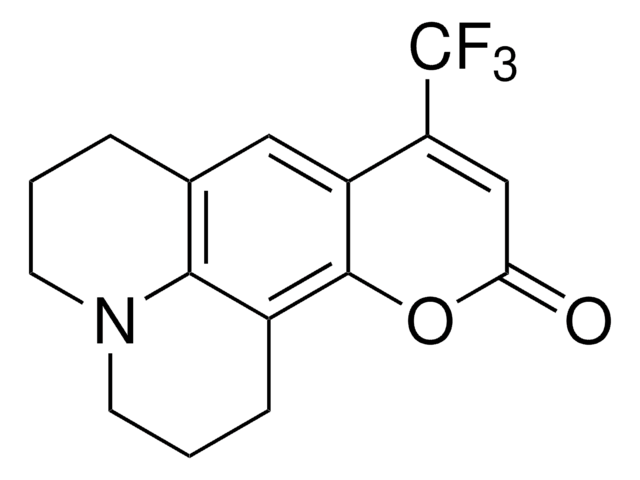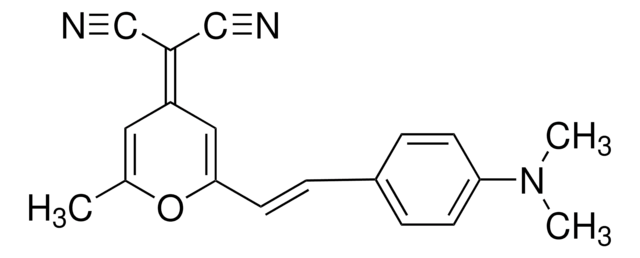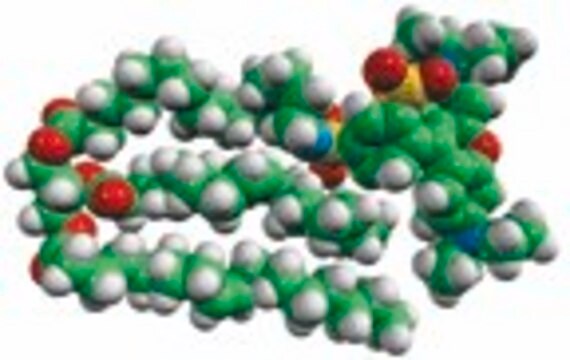おすすめの製品
品質水準
アッセイ
98%
形状
solid
mp
208-210 °C (lit.)
λmax
444 nm
蛍光検出
λem 505 nm in ethanol (Lasing peak 534 nm, lasing range 515 - 558 nm (DMSO), pump source XeCl (308 nm))
OLEDデバイス性能
ITO/Alq3:Coumarin 6/Mg:Ag
SMILES記法
CCN(CC)c1ccc2C=C(C(=O)Oc2c1)c3nc4ccccc4s3
InChI
1S/C20H18N2O2S/c1-3-22(4-2)14-10-9-13-11-15(20(23)24-17(13)12-14)19-21-16-7-5-6-8-18(16)25-19/h5-12H,3-4H2,1-2H3
InChI Key
VBVAVBCYMYWNOU-UHFFFAOYSA-N
類似した製品をお探しですか? 訪問 製品比較ガイド
詳細
アプリケーション
- グリオーマ細胞株におけるブロック共重合体(BCP)ベースのミセルによる薬剤送達の研究
- グリオーマ細胞におけるフルフェナム酸(FA)との組合せによるナノプロドラッグ取り込み
- ポリ(乳酸-グリコール酸共重合体)(PLGA)によるエルビテグラビルナノプロドラッグ取り込みの研究
保管分類コード
11 - Combustible Solids
WGK
WGK 3
引火点(°F)
Not applicable
引火点(℃)
Not applicable
個人用保護具 (PPE)
Eyeshields, Gloves, type N95 (US)
適用法令
試験研究用途を考慮した関連法令を主に挙げております。化学物質以外については、一部の情報のみ提供しています。 製品を安全かつ合法的に使用することは、使用者の義務です。最新情報により修正される場合があります。WEBの反映には時間を要することがあるため、適宜SDSをご参照ください。
Jan Code
442631-VAR:
442631-1G:
442631-5G:
442631-BULK:
この製品を見ている人はこちらもチェック
資料
One of the common difficulties with intravenous drug delivery is low solubility of the drug. The requirement for large quantities of saline to dissolve such materials limits their clinical use, and one solution for this problem that has recently generated interest is the formation of drug-loaded micelles.
One of the common difficulties with intravenous drug delivery is low solubility of the drug. The requirement for large quantities of saline to dissolve such materials limits their clinical use, and one solution for this problem that has recently generated interest is the formation of drug-loaded micelles.
Developed in the last several years, fluorescence quenching microscopy (FQM) has enabled rapid, inexpensive, and high-fidelity visualization of two-dimensional (2D) materials such as graphene-based sheets and MoS2.
Graphene has emerged as the new wonder material. Being only one atom thick and composed of carbon atoms arranged in a hexagonal honeycomb lattice structure, the interest in this material has exploded exponentially since 2004 when it was first isolated and identified using a very simple method.
ライフサイエンス、有機合成、材料科学、クロマトグラフィー、分析など、あらゆる分野の研究に経験のあるメンバーがおります。.
製品に関するお問い合わせはこちら(テクニカルサービス)










